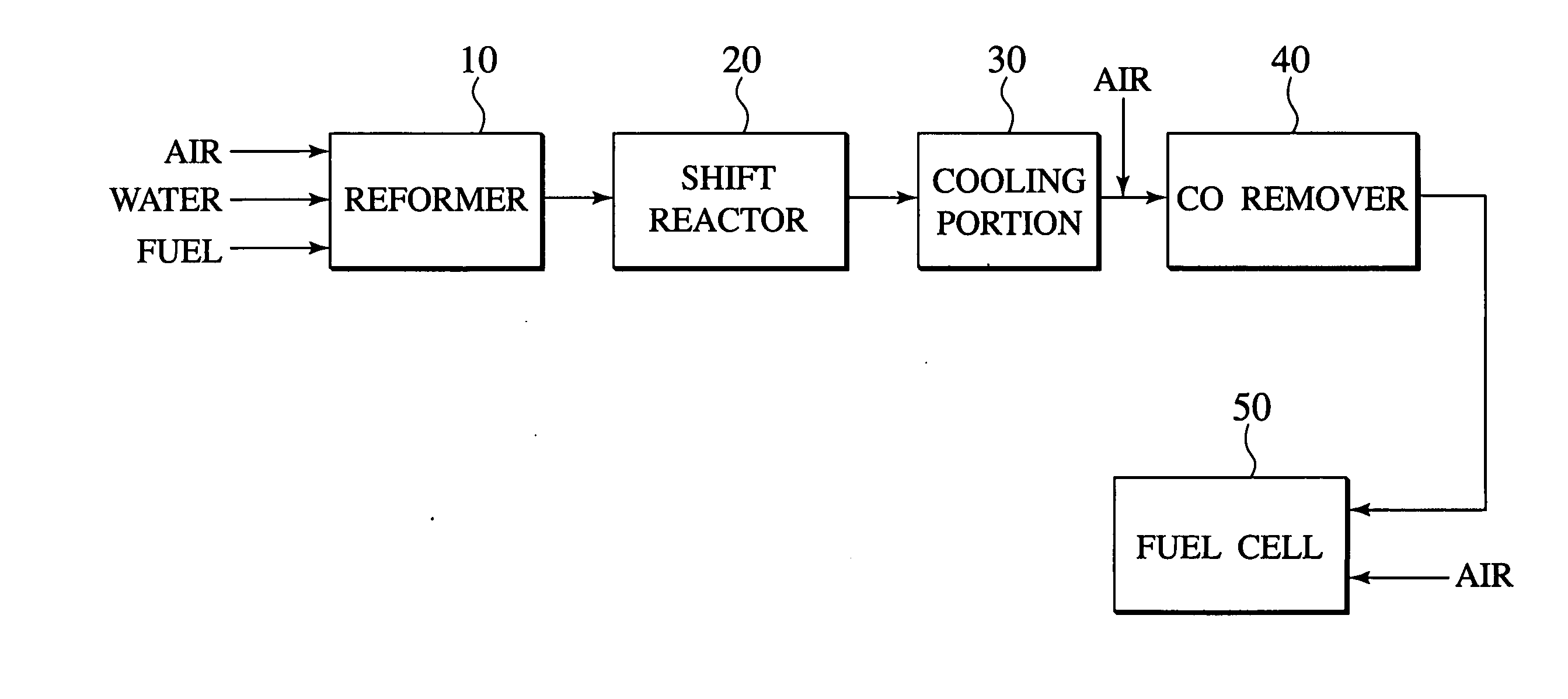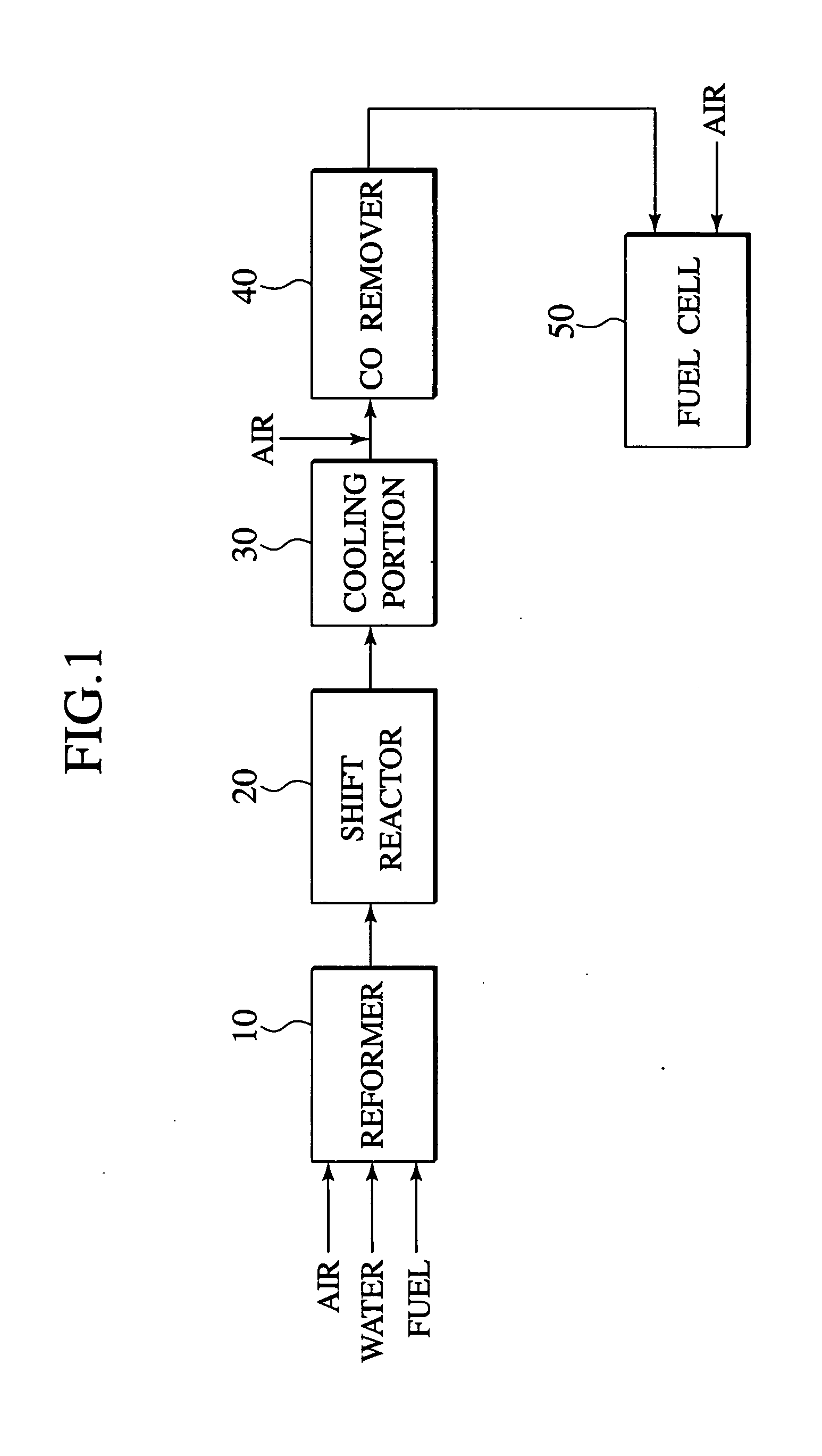Fuel Reforming Apparatus And Fuel Cell System
a fuel cell and reforming technology, applied in the direction of metal/metal-oxide/metal-hydroxide catalysts, physical/chemical process catalysts, bulk chemical production, etc., can solve the problem that the system may exhibit only poor reforming properties at start-up, unsatisfactory starting-up properties for the use of vehicles requiring excellent starting-up properties, and low catalytic activity, etc. problem, to achieve the effect of excellent hydrocarbon conversion rate, excellent h2+
- Summary
- Abstract
- Description
- Claims
- Application Information
AI Technical Summary
Benefits of technology
Problems solved by technology
Method used
Image
Examples
first embodiment
[0018]The first embodiment of the present invention is directed to a fuel reforming apparatus. The fuel reforming apparatus is an apparatus which reforms hydrocarbon contained in a fuel to form hydrogen, and has a catalyst packed portion which is a reaction tube packed with a catalyst. The catalyst packed portion has one feed inlet or a plurality of feed inlets for feeding at least fuel gas, oxidizing gas required for a reforming reaction, such as air, and steam gas, and a discharge outlet for discharging the reformed gas. The fuel reforming apparatus according to the first embodiment of the present invention has a characteristic feature such that the catalyst packed portion contains therein fuel reforming catalyst (I) having excellent hydrocarbon conversion rate and fuel reforming catalyst (II) having excellent H2+CO formation rate.
[0019]In the reforming reaction of hydrocarbon on a fuel reforming catalyst, when, for example, isooctane C8H18 [(CH3(CH3)2CCH2(CH3)CHCH3)] is used as a...
second embodiment
[0066]The second embodiment of the present invention is directed to a polymer electrolyte fuel cell system to which the fuel reforming apparatus according to the first embodiment is applied.
[0067]FIG. 1 shows a schematic construction of the polymer electrolyte fuel cell system. The system comprises a fuel reforming apparatus 10 according to the first embodiment, a shift reactor 20 for reducing carbon monoxide contained in the discharged gas from the fuel reforming apparatus 10 through a water-gas-shift reaction, a carbon monoxide removing apparatus 40 for removing carbon monoxide contained in the discharged gas, and a polymer electrolyte fuel cell 50. If necessary, the system may comprise a cooling portion 30, disposed between the shift reactor 20 and the carbon monoxide removing apparatus 40, for cooling the discharged gas from the shift reactor 20.
[0068]In the polymer electrolyte fuel cell system using, for example, isooctane as a fuel, as shown in FIG. 1, isooctane is reformed by...
preparation example 1
Catalyst Preparation Example 1
[0073]Al2O3 (BET specific surface area: 200 m2 / g) was used as a carrier, and the carrier was added to 0.36 liter of a 0.058 M aqueous solution of rhodium nitrate so that the carrier was impregnated with a rhodium element, and the resultant mixture was satisfactorily stirred, and then dried for one day, followed by baking at 500° C., to obtain catalyst 1.
[0074]Subsequently, 0.47 liter of water was added to catalyst 1, and the catalyst was wet-milled to prepare a slurry, and the slurry was applied to a honeycomb substrate made of ceramic (6 mils, 400 cells; hereinafter, referred to as “cerahoneycomb”) and dried at 120° C., and baked in air at 400° C. to obtain monolith catalyst 1. In the milling, a commercially available ball-type vibration mill was used, and the ball diameter, the milling time, the amplitude of vibration, and the number of vibration were adjusted so that the resultant slurry has an average particle size of 2 to 3 μm, and catalyst 1 was s...
PUM
| Property | Measurement | Unit |
|---|---|---|
| operating temperature | aaaaa | aaaaa |
| mass | aaaaa | aaaaa |
| mass ratio | aaaaa | aaaaa |
Abstract
Description
Claims
Application Information
 Login to View More
Login to View More - R&D
- Intellectual Property
- Life Sciences
- Materials
- Tech Scout
- Unparalleled Data Quality
- Higher Quality Content
- 60% Fewer Hallucinations
Browse by: Latest US Patents, China's latest patents, Technical Efficacy Thesaurus, Application Domain, Technology Topic, Popular Technical Reports.
© 2025 PatSnap. All rights reserved.Legal|Privacy policy|Modern Slavery Act Transparency Statement|Sitemap|About US| Contact US: help@patsnap.com



